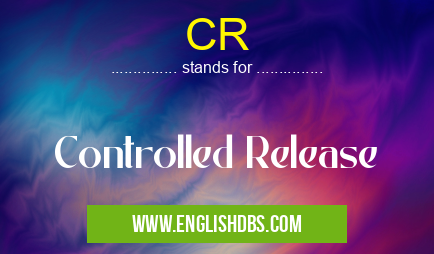What does CR mean in DRUGS
Controlled Release (CR) is a drug administration technique or form of pharmaceutical technology. It is used in the production and delivery of medications and other substances. This method involves the controlled release of a drug over a predetermined period of time, allowing for more efficient management of the medication and reduced risk to patients.

CR meaning in Drugs in Medical
CR mostly used in an acronym Drugs in Category Medical that means Controlled Release
Shorthand: CR,
Full Form: Controlled Release
For more information of "Controlled Release", see the section below.
Essential Questions and Answers on Controlled Release in "MEDICAL»DRUGS"
What is Controlled Release?
Controlled Release (CR) is a drug administration technique or form of pharmaceutical technology. It is used in the production and delivery of medications and other substances.
How does controlled release work?
Controlled release works by releasing drugs at a predetermined rate, which can be continuous or pulsed. In some cases, the rate can be adjusted to meet changing needs. The drug may also be released over an extended period, allowing for better absorption into the body.
What are some advantages of using controlled release?
Controlled release offers several benefits, including improved patient compliance with doctor-prescribed dosage regimens and fewer side effects due to smaller doses taken over longer periods of time. Additionally, controlled release methods maximize therapeutic effectiveness while minimizing potential toxicities as well as reducing costs associated with increased frequency dosing schedules.
Are there any limitations associated with controlled release technology?
There are some limitations associated with CR technology; most notably that not all drugs are suitable for CR formulations due to the nature of the active ingredient or its solubility characteristics in various environment conditions such as pH or temperature. Therefore, careful consideration must be taken when selecting drugs that require CR formulations for successful clinical results.
Who should use controlled release technologies?
Anyone who requires medication in a manageable dosage regimen should consider using CR technologies, as it allows for consistent management and delivery of certain medications over an extended period without risk to the patient's health or wellbeing through overdosing or underdosing on any given day/period. Additionally, caregivers can benefit from this form of drug delivery since they will likely experience less frequent trips to pharmacies while also ensuring proper medication adherence throughout their care plan.
Final Words:
Controlled Release (CR) is an effective way to improve patient compliance with prescribed dosage regimens while also reducing risks associated with improper overdosing and underdosing on any given day/period. In addition to this benefit, it has been seen that CR technologies can provide cost savings because fewer trips to pharmacies are required for ongoing treatment plans that rely upon consistent medication usage throughout each cycle. With individualized adjustments available when necessary, this form of drug delivery can be beneficial to individuals needing more accurate control over their dosing schedules.
CR also stands for: |
|
| All stands for CR |
